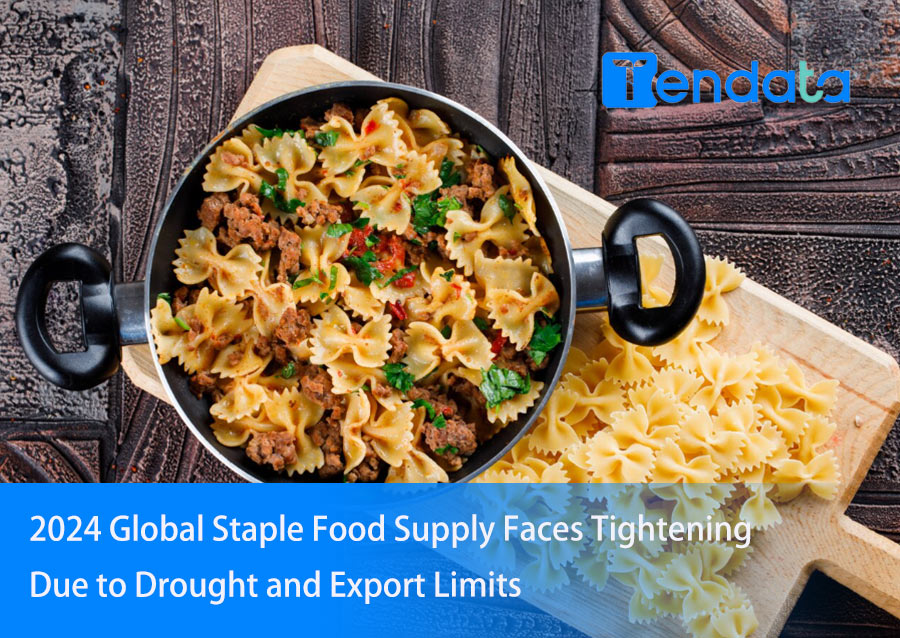 Trade Trends News
Trade Trends News
 05-01-2024
05-01-2024
In 2024, global staple food supply is expected to be tight due to drought conditions and export restrictions.
· The rice harvest in Asia in 2024 is anticipated to be affected by the El Niño phenomenon.
· Wheat crops in India and Australia face water stress.
· Palm oil production in Indonesia and Malaysia is expected to decline in 2024.
· Argentina and Brazil are expected to be agricultural supply highlights next year.

In recent years, high grain prices have prompted farmers worldwide to plant more cereals and oilseeds. However, adverse El Niño weather, export restrictions, and higher biofuel mandates are expected to lead to supply shortages for consumers before 2024.
Analysts and traders suggest that after several years of strong increases, global wheat, corn, and soybean prices are expected to decline by 2023, despite potential impacts from supply shocks and food inflation.
Ole Houe, Director of Consulting Services at Sydney agricultural brokerage firm IKON Commodities, said, "In 2023, with increased production in some key regions, the grain supply situation is expected to improve. But we haven't truly overcome the challenges."
"We expect the El Niño phenomenon to last at least until April or May. Brazil is almost certain to reduce corn production, and China's significant purchases of wheat and corn from the international market will surprise the market."
El Niño's Impact on Grain Production
The El Niño weather phenomenon, causing drought in much of Asia this year, is expected to persist into the first half of 2024, posing risks to the supply of top agricultural products such as rice, wheat, palm oil, and other commodities for exporters and importers worldwide.
Traders and officials anticipate a decline in Asian rice production in the first half of 2024 due to drought conditions and shrinking reservoirs that may lead to lower yields.
The El Niño-related production cut has already tightened global rice supply this year, prompting India, the largest exporter, to restrict shipments.
While the value of other grain markets depreciates, rice prices have reached their highest levels in 15 years in 2023, with quotes from some Asian export centers rising by 40%-45%.
India's next-season wheat crop is also threatened by inadequate water, potentially leading the world's second-largest wheat-consuming country to seek imports for the first time in six years, as domestic stocks in national warehouses have fallen to their lowest levels in seven years.
Australian Farmers
By April, Australian farmers, the world's second-largest wheat exporter, may plant crops in dry soil, as months of intense heat have limited this year's crop yield, ending hopes for a fourth consecutive record harvest.
This may prompt buyers, including China and Indonesia, to seek more wheat from other exporting countries in North America, Europe, and the Black Sea region.
The German commercial bank wrote in a report, "The supply situation for the current 2023/24 crop year (wheat) may deteriorate compared to the previous season."
"This is because exports from key producing countries may significantly decline."
On the bright side for grain supply, South American corn, wheat, and soybean production are expected to improve in 2024, but Brazil's unstable weather leaves some uncertainty.
In Argentina, abundant rainfall in the central agricultural zone could boost yields of soybeans, corn, and wheat, making it one of the world's largest grain exporters.
According to the Rosario Grain Exchange (BCR) in Argentina, due to rain in the Pampas region since the end of October, 95% of early-planted corn and 75% of soybeans are in "very good" condition.
Brazil expects agricultural production in 2024 to approach record levels, despite a recent downward revision in soybean and corn production due to dry weather in recent weeks.
Due to dry El Niño weather, global palm oil production may also decrease next year, supporting edible oil prices, which fell more than 10% in 2023. The decline in production is expected due to anticipated demand for palm oil-based biodiesel and cooking oil.
Leading agricultural lending institution CoBank in the United States said, "We believe the risk of price increases is greater than the risk of price decreases."
"Measured against historical standards, global grain and oilseed stocks are tight, and the northern hemisphere growing season may experience a strong El Niño weather pattern not seen since 2015. The dollar is expected to continue its recent decline trend, and global demand should return to normal levels in line with its long-term growth trend."
Category
Leave Message for Demo Request or Questions


 T-info
T-info T-discovery
T-discovery

 My
Tendata
My
Tendata Market Analysis
Market Analysis Customer
Development
Customer
Development Competitor
Monitoring
Competitor
Monitoring Customer Relationship
Customer Relationship





































































































































